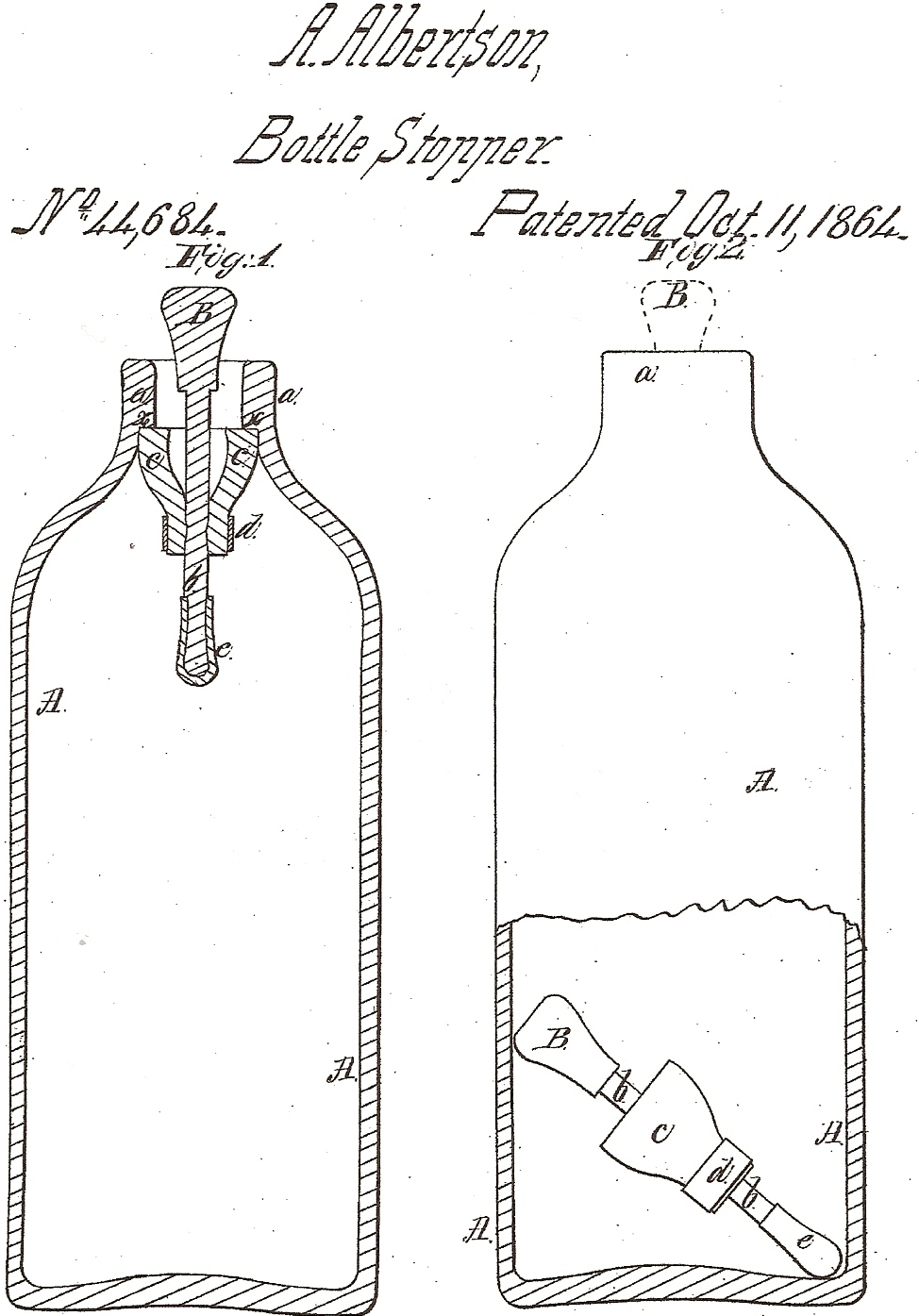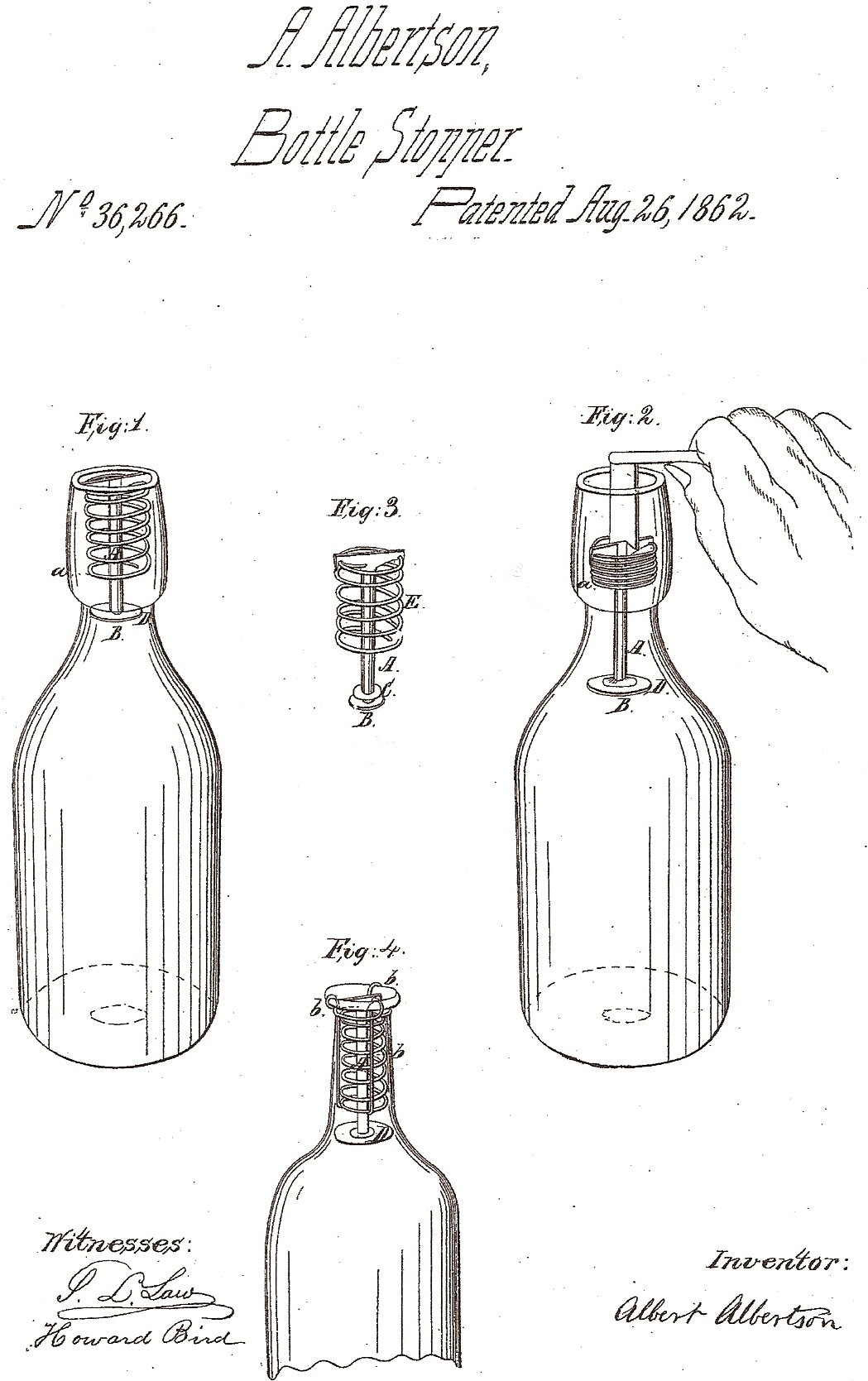Albert Albertson Bottle Stopper

Albert Albertson’s patent
application was filed circa August 8, 1864, assigned to J. N. McIntire,
his attorney, and ultimately re-assigned to the Firm of John Matthews in
I, Albert Albertson, of
Previous to my invention several methods of stopping
bottles have been suggested and patented, all having for a main object
to dispense with the employment of ordinary corks (which have to be
renewed at each filling of the bottles and are expensive) and avoid the
labor involved in the use of them, especially in bottling gaseous
liquids, where the cork has to be tied or otherwise secured in the mouth
of the bottle.
Among the inventions suggested heretofore, having for their objective the great desideratum of dispensing with the expensive and laborious system of corks and fastenings, the best method, to my knowledge, is that shown and described in Letters Patent granted to me on the 26th day of August, 1862 (see illustration);

but
experience and thorough practical tests have shown that in the method
patented to me there are serious objections when put into general use –
as, for instance, the liability of the mechanism to clog up, the
necessity of an instrument for the purpose of readily opening the mouth
of the bottle to empty it of its contents, and the liability of the
necks of the bottles, from their necessarily weak form, to break during
transportation or handling.
These objections and others I propose to effectually overcome by my
present invention, which has for a further object to produce a more
economical, durable, and desirable method of stopping bottles than any
heretofore known…
To those ends my invention consists in the employment
of a stopper which may be inserted through the neck of the bottle, and
so constructed that it can be brought into close contact with a suitable
bearing-surface or seat on the interior of the neck of the bottle to
close it, and be depressed or pushed down into the bottle to open
it…(and) any tendency to force it out will only tighten the joint
between the stopper and its seat in the bottle-neck…
My invention further consists in making the entire
stopper of a length exceeding the diameter of the bottle in which it is
to be used, so that the stopper while resting in the body of the bottle
cannot turn round, but must always present itself right end foremost to
the mouth of the bottle…
Figure 1 is a vertical or longitudinal section of a
bottle with the stopper represented in the position in which it closes
or stops the mouth of the bottle.
Fig. 2 is an elevation of the same, (with the lower portion of
the bottle broken out,) showing the position of the stopper after
opening or unstopping the bottle to empty it…
A is the bottle,
(of any shape or design,) on the interior of the neck of which I propose
to form a shoulder, as seen at x.
The stopper is formed of a stem or rod,
b, having a suitable knob
portion, B, and having secured
(or formed) on it a gutta-percha or other elastic or yielding valve or
cork, c. I have represented
the stem b as made of metal,
and with a thimble or cover, e,
of soft material – such as gutta-percha – at its lower end, the object
of which is to avoid any possibility of injuring the bottle by the
sudden contact with the glass of the hard stem, when the latter is
forced or drops down into the bottle in “opening.”
The valve portion
c, I have shown secured to the
stem b by means of a band or
collar, d, and an annular
depression in the stem b, into
which the yielding stock of c
is forced and held by the encircling-collar
d; but in lieu of this mode of
construction the entire stopper may be formed (if found practicable and
expedient) of rubber, the stem portion “hard,” with its lower end
“soft,” and the conical valve portion
c of the proper flexibility.
The position of the valve portion
c on the stem
b is such as to allow the knob
or upper end of the stopper to protrude a short distance beyond the
mouth of the bottle when the valve
c is…closed in order that the stopper may be readily forced down
into the bottle by pressure, or a blow with the hand to open the bottle…
I prefer to make the valve
c, as shown, conical, with
upper end hollow, and provide the interior of the neck with a shoulder,
x, for in this form of valve
and seat the stopper is readily forced up against its seat or shoulder
the valve c will be bulged or
upset and cannot be forced out, which is a desideratum where the
contents of the bottle embrace gas or fixed air – as, for instance, when
soda-water is contained…
To bottle soda-water and other gaseous liquids, (under
pressure), I take the bottle (thus provided with its stopper) and place
it in the filling-machine, in which the given quantity of water and gas
is supplied to the bottle, (the stopper remaining as seen in Fig. 2.)
I then invert the bottle while it is yet attached to the
supply-tube…when the stopper falls into the neck of the bottle, the
valve c resting in its seat, and in this position I disconnect the bottle
from the filling-machine, when the pressure within the bottle retains
the valve c against its seat
and keeps the bottle effectually closed.
When it is desired to empty the bottle, a slight blow or pressure
on top of the knob B will
cause the stopper to descend to the bottom of the bottle, as seen at
Fig. 2, and the liquid is poured out.
The stopper being of a much greater specific gravity than the
liquid and being so long, will not impede the flow of the liquid from
the bottle if it is gradually poured out…the emptied bottles are
returned to the factories (or filling-depots) and refilled as many times
as the duration of the bottle and stopper will permit.
Comments:
Albert Albertson’s innovations were important
developments in the evolution of bottle stoppers.
Bottles utilizing his August 26, 1862 and October 11, 1864
patents were manufactured by The Firm of John Matthews in
 HutchBook.com
HutchBook.com